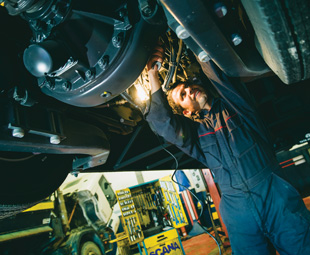Managing maintenance mayhem

Vehicle maintenance – possibly two of the most loathed words in a transport operator’s world … but technology is helping to manage this menace, while parts are becoming “smarter”. JACO DE KLERK dives into the digital domain of augmented reality and finds that components are also doing their part to overpower this necessary “evil”.
Maintenance costs are one of the biggest expenses faced by transport operators as they have to pay for the actual service, replace affected parts and deal with the downtime. Technology is, however, helping to curb these overheads.
Savvy software
Various systems are now available that monitor trucks while they operate, enabling preventative maintenance – with some even informing the workshop on what needs to be replaced before an operator is even aware that there’s a “problem”. Two examples can be found at the truck stables of Mercedes-Benz, with its Telligent Maintenance system, and Volvo, which offers Telematics Gateway.
The former takes cues from the actual wear and tear of the vehicle – calculating service dates for the engine, the transmission and the axle oil-change intervals. It also determines the dates for general service components – based on the operating conditions of the vehicle.
As we reported in FOCUS July: “This ensures optimum utilisation of operating fluids and service parts without risk to the service life or reliability of the engine and driveline.”
“Telligent Maintenance tells the driver exactly what needs to be serviced, and when. This leads to less time spent in the workshop. Effective usage of the system can realise a saving of up to 14 percent in service costs.”
Volvo’s Telematics Gateway follows the same principals; a remote workshop monitors the parameters pertaining to the vehicle’s condition. FOCUS assistant editor Gavin Myers elaborates in the report Viva Volvo! (FOCUS November 2013): “Fault codes can be read before a technician is sent to physically diagnose and repair a stricken vehicle, and servicing and maintenance can be scheduled in relation to the condition and use of each individual vehicle.”
A digital “how to” layered over reality
The motoring world is, however, also filled with other “space-age” solutions to enhance vehicle maintenance … enter Mobile Augmented Reality Technical Assistance (MARTA) – an augmented reality service support for Volkswagen’s (VW’s) XL1, a diesel-powered, plug-in hybrid concept car (turned limited production) that consumes fuel at less than 1 l/100 km.
Today’s commercial vehicles are characterised by continually growing complexity. This means that service employees will need more extensive support in servicing new vehicles and their innovative functions.
“This requires advanced development of the classic repair instructions that show the employee how to perform the tasks of the specific job, step by step, with relevant supplemental information such as the tools to be used, assembly configurations and test specifications,” states VW.
And this is exactly what MARTA does. Using the built-in camera on a tablet device, the program displays the real and virtual parts, in three-dimensional relation to one another, while offering service information in real time. So the technician is led through the whole maintenance process with a virtual “how to” guide while he is doing the actual servicing, eliminating the need to take a break and go back to the repair instruction manual …
MARTA shows the possibilities that augmented reality could hold for vehicle maintenance!
Just imagine how this could speed up the training process, technicians could receive a whole new level of “on-the-job training”. Workshop processes could also be speeded up, as the program identifies exactly which tools should be used for each application and technicians would be able to work on models that they’re unfamiliar with.
A brighter tomorrow
It seems that vehicle maintenance will be a lot less menacing in future; parts are being designed to speed up the process; systems are being implemented that inform a workshop when you’ll need what, before you even know you’ll need it; and augmented reality will be utilised to speed up whole maintenance process.
Bring it on you loathed duo …
Components doing their part
Original equipment manufacturers (OEMs) aren’t just combating maintenance costs by using some savvy software, they’re fighting it through the actual parts that they’re producing as well … MAN’s new 15,2-litre, six-cylinder, in-line D3876 engine is a stellar example.
It is said to be the top model in MAN’s Euro-6 engine range – with torque from 2 500 to 3 000 Nm, and power output between 520 (around 380 kW) and 560 hp (around 410 kW) for long-distance and towing vehicles, and 640 hp (470 kW) for heavy-goods vehicles.
The maintenance magic isn’t due to its power output, but is a result of how it’s been designed. Development of the D3876 was, reportedly, monitored at an early stage by experts from the company’s Service Engineering department, with the aim of achieving the most maintenance and repair-friendly design possible.
“For example, the valve train is accessible without prior removal of the air filter,” MAN relays. “Also, the extended diagnostic capability of the injection system provides more detail and hence reduces workshop effort.”
Things didn’t stop there. In certain assemblies, MAN also used proven components from the D20/D26 engine series; including the fuel filter, oil filter module and oil separator, the coolant pump, throttle valve, control cylinder for the exhaust gas recirculation system, the fan drive, auxiliary drive, alternator, starter and air conditioning compressor.
“This has enabled the company to incorporate the servicing and repair friendliness of the smaller engines into the 15,2-litre engine,” states the OEM. “And it is also a sound basis for straightforward parts provision.”
Published by
Focus on Transport
focusmagsa




